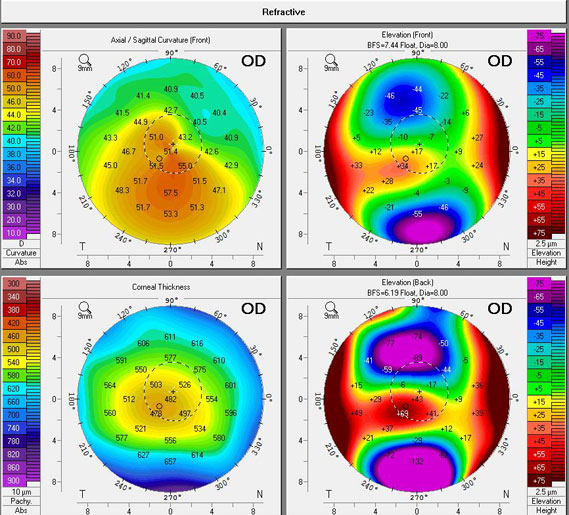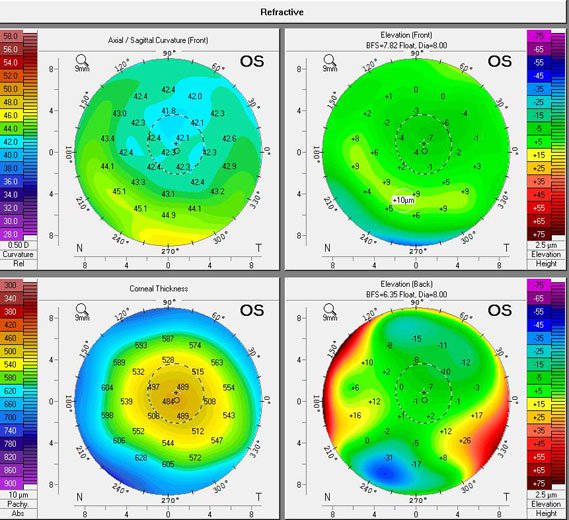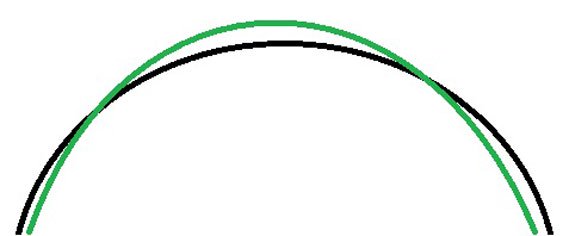BLOG: Evaluation for keratoconus crucial for presurgical patients
We’d like to change gears from cataract postoperative care and talk about corneal and refractive surgery.
A relatively simply diagnosis for optometrists to make is that of advanced or even moderate keratoconus. Even without cutting-edge technology, the diagnosis is relatively readily achieved. Oil drop reflex with across-the-room viewing of the pupil with the ophthalmoscope (you all still have yours, right? ... Seriously, this test is the only time I pick mine up), extreme irregularity on retinoscopy, high astigmatism paired with poor best-corrected visual acuity and specific slit lamp findings such as Fleischer ring and Vogt striae, make this diagnosis pretty simple to arrive at.
The diagnosis of early keratoconus is, however, much subtler. There will be no slit lamp findings, retinoscopy and ophthalmoscopy reflexes may be normal, and best-corrected vision will often be, if not 20/20, at least not so reduced to raise alarm, essentially removing all of the simplest ways to identify the disease. While 20 to 30 years ago, early identification of keratoconus was unimportant – the disease would eventually manifest and require treatment with a gas-permeable contact lens or transplant, or it would not and remain subclinical, today early identification is critically important for two reasons: refractive surgery screening and consideration of corneal cross-linking.
One of the most important things that can be assessed when considering refractive surgery for a patient is to make sure that they do not have forme fruste keratoconus, as subsequent excimer ablation will almost certainly cause their disease to manifest clinically and may lead to visually devastating consequences for the patient. While current research is extremely vague on precise risk factors that lead to post LASIK ectatic processes, one point on which there is no debate is that LASIK on keratoconics, at any stage, must be avoided.
Early diagnosis more crucial than ever
More recently, the early diagnosis of keratoconus took on new importance with the emergence (and much later) FDA approval of corneal cross-linking as a treatment to halt various keratoectatic disease, including keratoconus. While it seems that crosslinking is effective at halting the progression of keratoconus at the individual level and is effective at reducing the number of corneal transplants performed for keratoconus at a societal level, the procedure holds the most promise for patients with early keratoconus, as they may be able to avoid manifestation of all negative downstream consequences of their disease: irregular astigmatism leading to necessitation for GP use and corneal transplant.
LASIK evaluation and screening for corneal cross-linking make identification of keratoconus at its early stages crucial in modern eye care, particularly as it relates to comanagement of patients for LASIK and corneal cross-linking. For this reason, we’d like to discuss one of the techniques that is used at our clinics to screen for these patients.

I have told several of my friends in private practice that for me to consider myself functional were I to jump from a comanagement center to a private practice, I’d need to have a Pentacam (Oculus). The reason for this requirement is simple: I don’t think there is another instrument that is as versatile and useful in the diagnosis and monitoring of anterior segment disease, and, as such, in the cornea clinic where I work, I’ve become extremely dependent on it. My friends then tell me to stay in comanagement because my tastes are too expensive for private practice. The point here is that the Pentacam – with which neither I nor Ami have any affiliation, financial or otherwise – is an extremely powerful instrument that allows assessment of corneal pathology that is not possible with other devices.
Scheimpflug camera
The Pentacam is a Scheimpflug camera that measures up to 30,000 points on the anterior segment per scan and is able to assimilate these points to create an accurate 3-D model of the cornea and anterior chamber. This imaging allows assessment of a number of features on the anterior segment including those that are very familiar (corneal topography) as well as those that are of a more niche interest (Zernicke analysis of aberration), and each of the possible analyses is viewable after a single scan (meaning you don’t have to run different scans to view different reports).

You don’t have to wander far down the report option list to view what I consider to be one of the most useful printouts in all of eye care: Pentacam’s four-map refractive report. On this report we see a familiar topography, a pachymetric assessment of the entire cornea and maps of what are known as anterior and posterior elevations. While each of these metrics is extremely valuable in the diagnosis of keratoectasias, topography and pachymetric changes seen in the disease are well understood by optometry. For this reason, we’d like to focus our attention on understanding the elevation maps, as the concept behind them is largely unknown in optometry but critically important to the early diagnosis of keratoconus.
Elevation maps
Many sources consider the genesis of keratoconus to begin in the posterior cornea, where inherent weakness of corneal tectonics in the keratoconic eye, mechanical insult (via eye rubbing) or some combination of both cause the posterior cornea to weaken and bulge forward slightly. This bulging occurs directly under a thin zone, which causes the area to thin, leading to further bulging of the posterior cornea and further thinning. Eventually this perpetuates to create the topometric changes characteristic of the disease and, until relatively recently, this was where the disease was able to be diagnosed – when topography manifested some abnormality.

With modern technology however, these initial posterior corneal changes can be assessed to identify at-risk eyes, in some cases well before topometric changes occur. The Atlas (Zeiss) topographer, the Orbscan (Bausch + Lomb) and the Pentacam are all devices that are able to assess for these posterior corneal elevation changes.
Reference shape
With the Pentacam, the computer assesses the curvature of the patient’s own posterior cornea and assigns a reference shape that averages out the multiple curvatures that exist over each of our cornea to form an average specific to the reference shape that is being used. The most studied reference shape is the Best Fit Sphere (meaning the device assigns a sphere whose radius of curvature is the average of all of the measured points on the patient’s cornea), but other reference shapes are available. The patient’s actual posterior corneal curve is then overlaid on top of the reference shape, and the distance between the two are measured in micrometers. Areas where the actual corneal curve is anterior to the reference shape are called zones of “positive elevation,” and those that are posterior to the reference shape are “negative elevation.” It’s important to note that while dramatic irregularities in elevation often correspond with dramatic irregularities in curvature, this is not a measure of radius of curvature of keratometry, it is an actual measurement of the physical separation in space between an ideal reference shape and the patient’s own corneal shape. Patients with keratoconus will often have zones of positive elevation that correspond with the thin zone of their cornea and, while extreme elevations are common in advanced disease, in early disease these irregularities are much more modest.
Essentially, any posterior elevation over a Best Fit Sphere reference shape over the thinnest part of the cornea of greater than 15 µm is considered abnormal and should derail a LASIK evaluation and lead to further follow-up to assess for changes that might be consistent with worsening keratoectatic disease. Further, although posterior elevation receives most of the attention (and is now part of the diagnostic criteria set forth by the Global Consensus on Keratoconus), anterior elevation (reflective of spatial abnormalities of the anterior cornea) may also be abnormal in keratoconics as well as a number of other diseased states (Salzmann’s nodules, for example).
Although they are quite sensitive to keratoectatic processes, posterior elevation measures are not able to detect all keratoconics at the earliest juncture nor are they so sensitive when positive that I would make a recommendation on corneal cross-linking based on high posterior elevations alone. Limitations aside, they are an indispensable metric in the modern diagnostic algorithm of assessing the risk of a patient for developing keratoectasia. This utility is felt most keenly when assessing patients for LASIK or corneal cross-linking.
Further, although the concept of posterior elevation is unfamiliar to a wide swath of practicing optometrists, it is, more and more, becoming a standard metric in corneal assessment at surgical facilities. So, whether or not you intend to rush out and purchase a topographer that provides this information, it’s our hope that this brief primer on a poorly understood, but critical, measure is useful in helping you understand a more commonly used bit of jargon and why it is helpful.
Reference:
Sandvik GF, et al. Cornea. 2015;doi:10.1097/ICO.0000000000000460.
Gomes JA, et al. Cornea. 2015;doi:10.1097/ICO.0000000000000408.
